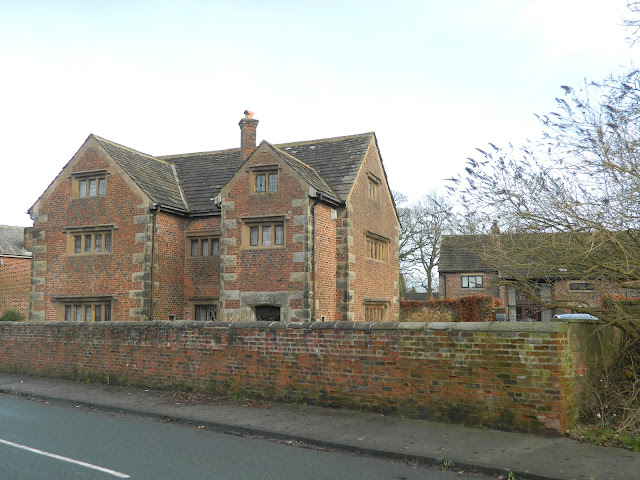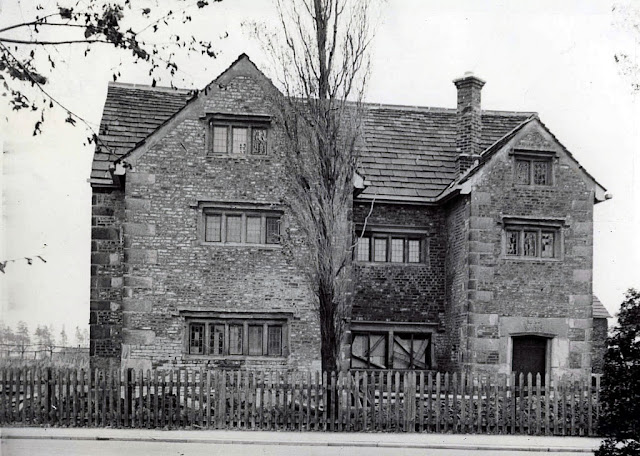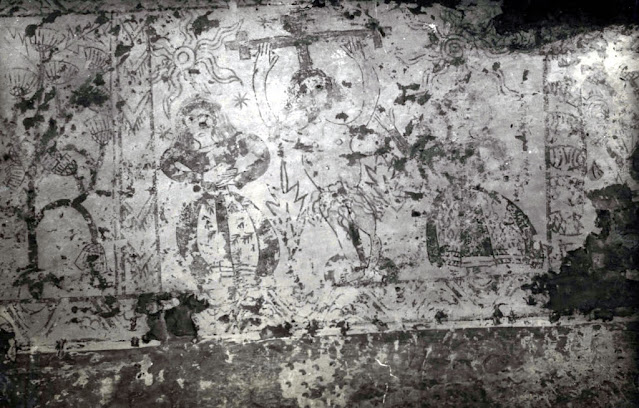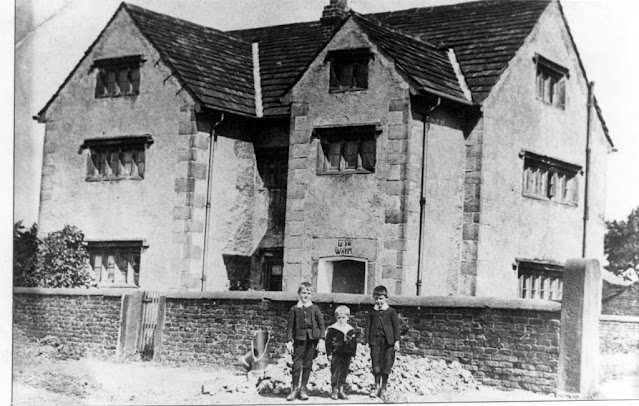Todd Hall a Listed Building
Dating Back to 1630
Todd Hall is a Grade II Listed Building that dates back to 1630. This makes it the oldest building in the South Ribble area, and generally around Preston. It was restored in 1938 by A. C. M. Lillie, a local architect, after lying derelict for ten years.
The Bamber Bridge Architect A.C.M. Lillie's work included the New Patients Wing at Preston Royal Infirmary and the tower on St Paul's Church, Longridge.
 |
| Todd Hall a Listed Building Dating Back to 1630 |
The moulded stone doorcase, with Tudor-arched lintel, is lettered in relief: 1630 W(?) IC.
 |
| Moulded Stone Doorcase Lettered in Relief 1630 W(H)IC. |
I think that could be WHIC. An early Ordnance Survey map makes reference to Todd Hall and also Todd Lane, the road on which sits. However, an earlier maps that I have been studying does not. This make reference to the name 'Hanshaws' in that area. I am wondering whether my my interpretation of the letter 'H' (aitch) has anything to do with Hanshaws? Below is a section from 'A map of the County Palatine of Lancaster' from an accurate survey in the year 1828 by G. Hennet & James Bingley.
 |
| Section from a Map of the County Palatine of Lancaster, 1828 by G. Hennet & James Bingley |
The full map is available from the National Libraries of Scotland:
https://maps.nls.uk/view/220113211
That might be a line of enquiry that doesn't quite match up. I have used an online tool to look at a georeferenced version of this map, and the marker for Hanshaws seems to match up with something further north than Todd Hall. There is another place identified in that area, but it is hard to say which mark on the map belongs to the text. There is a property identified as 'Brown Lodge', could this have anything to do with the Todd Hall that we know today?
Memories of a Ninety Nine Year Old
Below is an account of the place given by a local woman (...who I currently cannot identify) in around 2013.
I was born in 1914 and when I was a young girl my mother was often ill. I was sent to church but never confirmed. We lived near Four Lane Ends on Brownedge Road.
Todd Hall - When I was about 8 or 9 years of age, Todd Hall on Todd Lane North was derelict. All the local children used to go in and play inside, especially when it was raining and during the summer holidays. We used to get in round the back. We would go for the day and take a basket of jam and bread and a bottle of Kali powder and water, which made a fizzy drink. There was a big fireplace and we would stand inside it and shout up the chimney. In the corner of the room was a staircase which led to an upstairs room which had a clay floor. The boys would dare each other to creep across it on their hands and knees, it was not safe enough to walk on. One day we were throwing our ball against the wall and the whitewash started to flake off. We carried on playing then a face appeared it was a pinky brown colour, so we started to pick it off with our fingers, we scraped quite a bit off. When we went back to school after the summer holidays were over we always had to write about what we did during the holidays for our composition. This year we wrote about the picture and going in Todd Hall. The teachers must have told the police or the Evening Post about it, because the next thing we knew it was being boarded up by Kevill's, who had the lease on it. So in a way we did ourselves a thick one as we were never allowed to play there again.
It was discovered that the picture we found under the whitewash was a painting of 'The Last Supper'. The painting was on the right hand side of the fire place.
 |
| Todd Hall a Listed Building Dating Back to 1630 |
TODD HALL GIVES UP ITS SECRETS (1938)
CUPBOARD WITH FALSE BACK LEADS TO A DARK CELL – HIDING PLACE OF 17th CENTURY PRIESTS.
Bare bricked and mysterious with two tall poplars before its sober Jacobean front. Todd Hall faces the lane named after it in Lostock Hall near Preston. It is one of Lancashire’s mystery houses. For centuries its yellow, narrow stone windows have looked over the flat landscape around it, and no one has guessed, or, it appears, even suspected, the secrets of its thick walls and dark cupboards, which I am able to reveal exclusively in this article. They were discovered last week by Mr ACM Lillie, the Bamber Bridge architect, who is restoring the house.
 |
| Todd Hall a Listed Building Dating Back to 1630 |
TEN YEARS SILENCE. Except for the birds that sing under the heavy flagged, mossy roof, this 17th century house has stood silent and empty for more than 10 years, and the semi-detached houses and bungalows that have been built around it only seem to have strengthened the spell of its age. The main door protected by a stone porch is studded with rusty iron. The latch scrapes on the wood and the hinges complain as it creaks open into a small vestibule leading to the dining room. One of the Jacobean windows breaks the dimness of the room and shows a massive oak beam running over an open brick fire-place which recedes into the back wall. On the right of the ingle is a small square recess with shelves fitted into it. Behind this apparent innocent, though picturesque structure, is the centuries old secrets of Todd Hall. After careful use of a tape measure, Mr Lillie, who was planning to restore the house for a Chorley solicitor, became suspicious of what appeared to be a disparity between the depth of the wall and the depth of the ingle. Workmen began knocking down the wall to confirm the abnormal thickness of the brickwork which the tape measure indicated. To their amazement, after the first few bricks their pickaxes slipped into a cavity. They ripped down a section of the wall to the floor, and found themselves looking into the entrance of a dark cell. Striking matches they stepped inside. They were behind the ingle in a narrow, small room. They were possibly for centuries, the first men to enter what had all the evidence of a priest’s hiding place.
RELIGIOUS BIGOTRY. These secret rooms, which are a feature of many old Lancashire houses, were made during the period of religious bigotry in England when the Catholics were hounded and persecuted for their faith.
Queen Elizabeth was responsible for a more stringent application of the existing prohibition, and penalties against Catholics in the 16th century and even later, when Todd Hall was built (1630) ten years after the Guy Fawkes affair, the hunting and punishing of Catholics was as fierce as ever. Priests were sheltered in large houses and retired into their hiding places when searchers were in the area. The ‘cupboard’ in the ingle of Todd Hall has a false back, and makes an easy communication with the hiding place behind it. A brick shaft, wide enough for a man to climb through, has been built in the hiding place and leads, it was found, into a large cupboard in a bedroom on the first floor. No doubt this cupboard was used as a wardrobe, and the false floorboards have been so cleverly made that, even bared, they yield no clue of their real purpose. They lift up easily and allow quick access to the shaft dropping down into the hiding place.
SECRETS UNBETRAYED. Many of these secret hiding places were made by Nicholas Owen, who served his apprenticeship as a mason and carpenter before he became a Jesuit priest. Owen travelled by day but his real work was done at night. By the glow of his lantern he built hiding places that remained undiscovered for centuries after he had laid down his tools. Expert carpenters and masons used to accompany the pursuivants, as the priest hunters were called to pit their detective skill against Owen’s genius for deception. He died after appalling torture in the Tower his lips closed, his friends and secrets unbetrayed. Although the ingle of Todd Hall was probably built many years after his death, the ingenuity of this newly discovered hiding place suggests the influence of his methods. A section of the wall at the back of the hole obviously juts out from the main line of the design outside, but inspection satisfies one that this space can be accounted for by the receding ingle in the dining room. I walked with Mr Lillie through the back door with what I thought was an accurate impression of the depth of the ingle, and a few moments later made a mental comparison with the wall outside. I could have been sure that no space behind the ingle and the back wall was possible.
A DECOY HOLE. Another discovery made a few days later was a ‘decoy hole’. These decoy holes were built so that they were not quite perfect enough to elude the thumping staves, sensitive fi ngers and prying eyes of the hunters. They were always empty of course, and were built with the purpose of persuading the pursuivants that they had found the only hiding place (empty) and that there was no use in continuing the search of that house. Hiding places and decoy holes in many old halls and manor houses have been bricked up by imaginative owners who were fearful of giving family ghosts too much licence. Shortly after the discovery of the decoy hole workmen chipping off old plaster above the mantelpiece in the bedroom where the entrance to the hiding place had been found saw traces of colour on their chisels.
They stopped hammering and carefully peeling off the remaining plaster found a faintly coloured picture appearing on a dullish white background. Mr WN Simm, the deputy art curator of the Preston Art Gallery, who also came to the Hall, is trying to trace the history and significance of the strange picture, which appears to represent a crudely-drawn Christ with the two Marys on each side of him.
 |
| Crudely-drawn Christ with the two Marys from Todd Hall |
30 TON ROOF.
My second visit to Todd Hall was with a Lancashire Daily Post camera man. We were both wearing, well at least clean suits. We came out with the pictures you see on this page looking as though we had been cleaning the chimneys. Most of the ceilings have been stripped to the rafters, and to get correct camera elevations we balanced on dusty oak beams with drops of 10 to 20 feet below. All the workmen had left, and the rain was blown by a blastering wind through the pane less windows. The thick walls of the Hall show their age and seem to sag under the heavy roof. Mr Lillie tells me this roof is made of stone flags and weighs from 25 to 30 tons ! Lancashire has many old buildings like Todd Hall, with their concealed traps, false cupboards and hiding places. They are mystery houses. Their secrets come to light after centuries, and their histories, for the most part, have been lost in the dark age of intolerance and religious persecution.
E.L.G.
Lancashire Daily Post
20th May 1938
I picked up the Lancashire Daily Post article from the 'Lostock Hall Mag' in Issue 20. The article 'Memories of a Ninety Nine Year Old' comes from Issue 13.
Lostock Hall Mag - http://www.madeinpreston.co.uk/LostockHallmagazine.html
 |
| Children Stood Outside Todd Hall a Listed Building Dating Back to 1630 |
---------------------------------------------------------------------------
Comments
Post a Comment